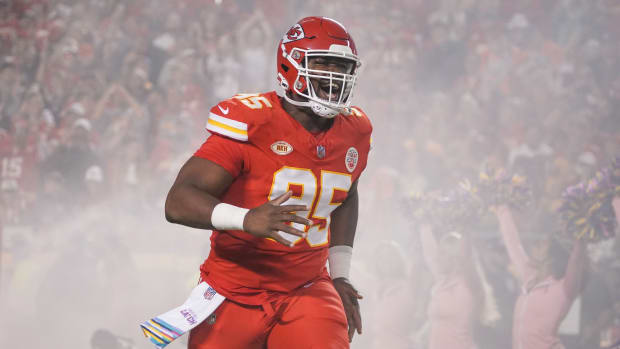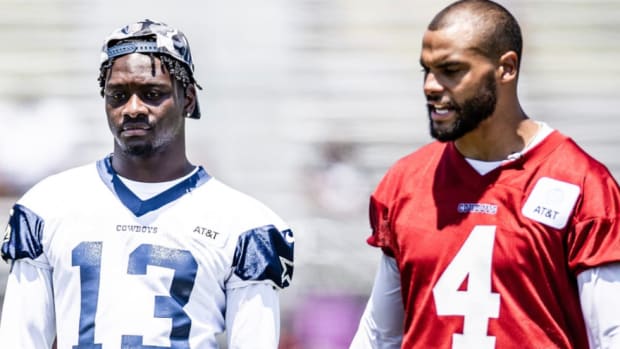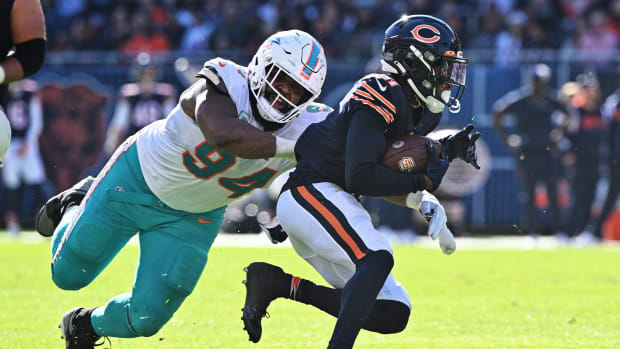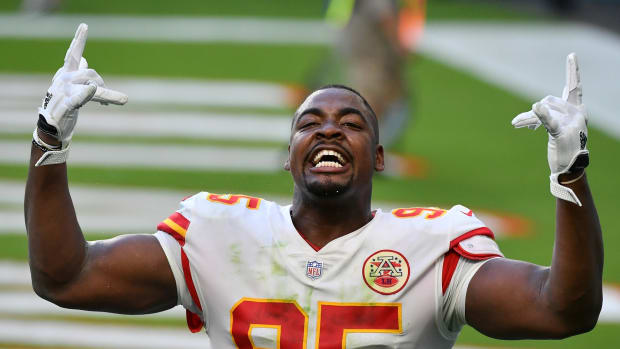In Canton, Plans for an NFL Retirement Home
CANTON, Ohio — The stadium at the Pro Football Hall of Fame is built like an amphitheater. A high wall of seats overlooks a main stage where, earlier this month, the greats of the game sat shoulder to shoulder in gold jackets. The seven newest inductees unveiled their bronze busts and gave speeches that roused the crowd. The best parts of the game were celebrated that night: athletic feats, will power, camaraderie, the platform to deliver messages with broader societal impact.
If you looked beyond the stadium’s goalposts, a few hundred feet to the northwest, in the midst of a residential neighborhood, you’d find a plot of land intended for the side of the game that doesn’t draw thousands of cheering fans.
Right now, between Blake and Clearview Avenues in this small Rust Belt city, there are only piles of dirt and recently vacated houses ringed off by yellow rope. But by 2020, the Hall of Fame plans to construct a place where the game’s legends can spend their final years.
It’s a concept that doesn’t exist anywhere else in professional sports: a retirement community for Hall of Famers and their partners, as well as other former NFL players, coaches and administrators. The renderings show a 143-bed facility that would draw from their shared pasts—a goalpost window frame in the main entrance, an automobile garage named for former Washington coach Joe Gibbs, a library housing decades of old NFL game footage. But the main purpose would be to serve the often uncertain futures many players face after the game, with senior care, assisted living and a separate memory care wing for those with cognitive diseases.
For those who walk through the Hall of Busts and remember the greats of the game as they once were, perhaps it’s hard to envision some of these names living side by side in a senior facility as their mental and physical health fades. But it’s also hard to fathom that there isn’t already a place like this—where post-football consequences are given as much care as past football glories.
Never have the risks of the game been more front and center than they are today. On the eve of this year’s Hall of Fame induction, members of the Class of 2017 openly admitted their worries about their long-term physical and mental health. Said running back Terrell Davis: “We’re all scared; we’re all concerned. We don’t know what the future holds.”
Former players do not unanimously nor uniquely face debilitating health problems like dementia; but, the pervasive concerns are substantiated by research such as that published in the Journal of the American Medical Association last month, which recorded the degenerative brain disease chronic traumatic encephalopathy (CTE) in 110 of 111 deceased NFL players whose brains had been donated for research. There was a selection bias, since most brains were donated because the players had shown symptoms of impairment while they were alive, so the research does not prove incidence or causation. Still, the weighty roll call continued to cast a pall over the game.
Among the 310 people enshrined in the Hall of Fame are Mike Webster, the longtime Steelers center and Hall of Famer who killed himself at age 50 after suffering from dementia and depression and living out of his truck for a long period of time; Junior Seau, the great Chargers, Dolphins and Patriots linebacker who committed suicide at age 43; and Raiders quarterback Ken Stabler, who like Webster and Seau, was diagnosed with CTE posthumously. Their stories have served, at least anecdotally, as a warning bell for the contrast between the highs of the football field and the lows that some face afterward.
The retirement community, called Legends Landing, is one part of a nearly $800 million development project at the Hall of Fame that’s being billed as a Disneyland for football. The refurbished Tom Benson Hall of Fame Stadium was the first step. Also in the plans are a hotel, a youth sports complex, an indoor performance center, a promenade with retail and restaurants and even a football-themed indoor water park. On the back edge, where houses once stood, will be the Player Care Center, a private building that would include an orthopedic sports surgery center, a 20-bed behavioral science and addiction center with which Cris Carter, who overcame addiction himself, is involved, and the Legends Landing.
The concept follows a growing trend among baby boomers, of so-called affinity retirement communities for people with shared interests or careers. Some Hall of Famers may want to live at Legends Landing simply for the camaraderie and the proximity to the mecca of the sport they love. But for those facing health crises, it’s not insignificant that the Pro Football Hall of Fame would have on its campus a 24-bed memory care facility intended for former players—particularly during an era when concussion lawsuits and the safety concerns threatening the long-term growth of the sport have resulted in many in and around the league taking great measures to sidestep the issue of head trauma entirely. (Case in point: Bills owner Terry Pegula telling reporters earlier this month, “I don’t like to talk about concussions publicly.”)
‘I Feel Lost. I Feel Like a Child’: The Complicated Decline of Nick Buoniconti
The genesis of Legends Landing came almost a decade ago, shortly before Gene Upshaw, the late director of the NFL Players Association, passed away. A former player himself, Upshaw was passionate about serving retired players’ needs. Mike Ornstein, a former executive with the Raiders under Al Davis, recalls driving with Upshaw to donate a bag of charity golf tournament polos to a California retirement community whose residents had worked in the movie and TV industry. The visit sparked the idea of doing the same thing for the NFL community.
“We said, this is what we need, because this eliminates anybody saying we don't take care of our own,” Ornstein says. “Hopefully, we could avoid having another Mike Webster, who didn’t have a place to go.”
They began to work on plans, but in August 2008, Upshaw suddenly fell ill and succumbed to pancreatic cancer in a matter of weeks. About a year after Upshaw’s death, Ornstein says he presented the idea to commissioner Roger Goodell, one of a few presentations he made at NFL headquarters over the next few years. A 2013 proposal for an “NFL Village,” presented to league executives and former NFL players Troy Vincent and James Thrash, quoted from an open letter to Goodell signed by 17 Hall of Famers pleading for better medical care for former players. It even suggested a wing of the facility to be named after Goodell.
But the idea didn’t take hold until David Baker was named president of the Pro Football Hall of Fame in 2014. Baker came onto the job with a unique perspective: He had experience developing an integrated health village in Nevada, and his son, Sam Baker, is a former first-round pick of the Falcons who played seven seasons in the NFL as an offensive tackle. Not long after his appointment, Baker met with Stuart Lichter of the Industrial Realty Group, who pitched the idea of a large-scale development around the Hall of Fame. Baker saw an opportunity to marry the idea of a player retirement community to this broader Hall of Fame development project.
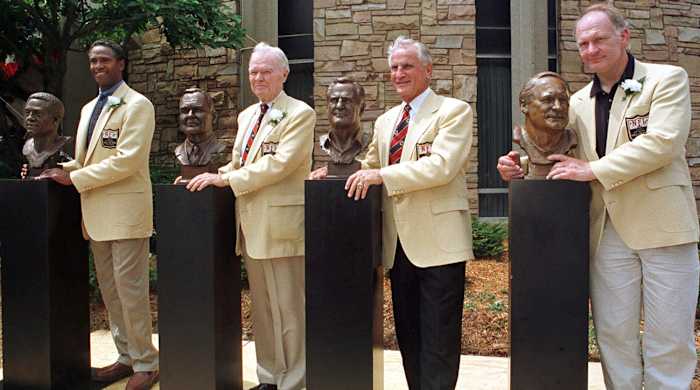
Mike Webster (far right) was enshrined in 1997. Five years later he died homeless and broke, suffering from a number of physical and mental ailments.
Phil Long/AP
After just a few weeks on the job, the Monday after Super Bowl XLVIII in New York, Baker told the Hall of Fame’s newly elected Class of 2014 about the concept. “We should respect these guys and honor these guys. They gave a lot of their life, a lot of their body, to build this league that we all love,” Baker said.
Baker calls the NFL “extremely supportive,” but for now the project is entirely in the hands of the Hall of Fame. The price tag for the construction of Legends Landing could end up being as high as $50 million, and there will also be yearly operational costs, which Ornstein estimates to be around $10 million per year. The cost for residents is expected to be around a few-hundred dollars per day, but the hope is through fundraising, these services would be available to former NFLers regardless of whether or not they can afford it.
The NFL, to this date, has not pledged any support or funding to Legends Landing. The league offers a range of post-career benefits, such as long-term care insurance, disability and neurocognitive benefits and the John Mackey 88 Plan to reimburse as much as $130,000 in medical care for dementia, ALS or Parkinson’s disease each year. But for a league projected to reach $14 billion in revenue in 2017, per SportsBusiness Journal, committing a few million per year to help operate a facility created to care for retired players would seem to be an easy decision. (A league spokesperson did not reply to requests for comment).
Saints owner Tom Benson, who gave $10 million to refurbish the Hall of Fame’s football stadium, donated another $1 million for this facility. And during enshrinement weekend, former 49ers owner Eddie DeBartolo, a 2016 Hall inductee, said he hopes to team up with Cowboys owner Jerry Jones to make a significant contribution toward the construction of Legends Landing.
“Once everything settles down, we are going to get together,” said DeBartolo, who in his Hall of Fame speech spoke at length about a sense of duty and responsibility to take care of the people who have played the game. “There is a total need for this. We are seeing (long-term health struggles) with our players, with every team’s players. You have to take care of them when their uniform is off.”
Jones, who was inducted into the Hall of Fame this year, said he didn’t want to speak as of yet about any potential contribution. But, he went so far as to liken the Hall of Fame Village project to professional football’s “own Vatican,” and said he’s the “biggest proponent of all” for the Legends Landing facility.
“To give deserving ex-professional football players places to live at a time of need is something that will be great for our league,” Jones said. “You have a natural environment for ex-players to feel good, to rehab, to get treatment, to get medical care and to live. I think it is very, very important in the care of the elderly that they be respected. Where will a former football player be respected more than in Canton, Ohio?”
How Jim Kiick Fell Through the Cracks
During enshrinement weekend this year, with bulldozers and construction sites visible around Canton, word of the retirement community spread among Hall of Famers. Helen Taylor, wife of Jim Taylor, the first Packers player from the Lombardi era to be inducted into the Hall, said it was a topic of conversation among other players’ wives during a luncheon in Canton.
Helen and Jim have made their home in Baton Rouge, where they were both born and raised, and have family, friends and a church community. But Taylor will be 82 this September, and Helen has noticed some differences in his short-term memory that will warrant further testing. She’s starting to think more about their options for the future.
“Our minds are very open,” Helen Taylor said. “We don’t know what his health will be like down the road. It’s a great concept, and if Jim does have some issues, and you have to move to an assisted living facility, you might be just as willing to move to one there with all the resources they’d have available.”
Multiple health care partners, Baker said, would be involved with the Player Care Center. They also are in talks with research institutions who could use this as a base to study a range of sports injuries, including concussions and their short- and long-term effects in athletes of all ages. The group that will operate the senior facility, Franklin Companies, runs multiple such communities across the U.S. The independent living and assisted living units would be interchangeable, so that residents wouldn’t be uprooted if they need an additional level of care. The memory care facility would be in part based on the approach at the world-famous “Dementia Village” in the Netherlands—where caregivers dress in street clothes and residents live as normally as possible with free roam inside a secured environment—and would use elements like music, aromatherapy and technology for communication with family members to keep residents active.
Ornstein has started to reach out to NFL clubs for names of former players and coaches who might be candidates for a facility like Legends Landing. The truth is, pretty much everyone in the NFL knows someone grappling with post-football care options, whether because of physical, mental or financial struggles. Austin Kiick, son of former Dolphins halfback Jim Kiick and the point person for his care, hadn’t heard of the plans for Legends Landing but says he’d often wondered, as he navigated care options for his father, why a facility like this didn’t exist. “If we had a place like this down here in Miami, it would have been the first spot I looked to for my dad,” he said.
One limitation of Legends Landing is that, when finding care facilities for loved ones, many families prioritize a location close to home. Jim Kiick, who has been diagnosed with dementia and early-onset Alzheimer’s disease, has been in an assisted living facility in South Florida for a little more than a year. But as Sports Illustrated’s S.L. Price wrote earlier this year, the Kiick family’s eight-year sojourn to finding help and solutions to care for Jim was expensive, confusing and frustrating.
In Kiick’s first year in the NFL, 1968, he made about $30,000, and he never earned the kind of payday that would afford him endless options for care. The 88 Plan, which the family didn’t learn about until a few years after Jim’s dementia began to set in, now pays for him to live in the assisted living facility. But Austin still has to budget, between the costs of medicine and the additional add-ons that can make his dad’s quality of life better. They’ve registered for a payout from the NFL’s $1 billion concussion settlement but have yet to receive any money.
Overall, Austin is satisfied with the level of care his dad is receiving, but there are limitations. At age 71, his dad is physically more active than many of the other residents he’s around. That made the transition into a facility even tougher for Jim, who still likes to shoot hoops. A few times a week, he is taken to a nearby physical therapy facility where he works out and, if there’s time, they’ll put him on a computer to do some mental therapy. Austin wishes his dad got to do more.
He’s seen the way his dad lights up when he takes him by Dolphins practice, or when old teammates Nat Moore and Mercury Morris come to visit. There’s some evidence that those suffering from short-term memory loss can be comforted by being connected to long-term memories. A facility where former players could live alongside their NFL peers, and watch old game footage instead of playing bingo, would, as Austin put it, give them “a brighter outlook.” Legends Landing, and potentially similar satellite facilities in other parts of the country, is something he believes the NFL should be behind.
“Without those guys like my father in the 70s, I don't think the NFL would be what it is today,” Austin Kiick said. “At least then they can show that they are actively trying to make things better for these players, rather than saying, look, we just wrote you a check for $1 billion, now we'll let the lawyers pass out the money, and who knows who is going to get what? We haven’t seen a dime yet. It’s almost like, we did our part, we went to court, that was the verdict, now let’s wash our hands clean and get back to business. Now is the time to show our retired players we are actively trying to take care of them.
He added, “And even the current players, obviously they are making millions and millions of dollars, but they don't know what is going to happen to them. You walk into the NFL at 20 years old and it is a dream come true. You are not thinking about, What's going to happen when I’m 50? Am I going to have money when I’m 50? Is someone going to be there to take care of me if I don’t have a wife or kids that are around?”
Head Games: The Moral Calculus of Football and CTE
Those involved with Legends Landing, from the Hall of Fame to the developers to Ornstein, speak confidently about it moving forward, even as they wait for additional funding sources (including, perhaps, from the NFL or other owners). “Based upon who has expressed interest to me,” Baker said, “I’m confident about the people who will meet this need.” Baker cited a 2020 targeted completion date, in time for the NFL’s 100th anniversary. And progress is already being made on the ground. On the block designated for the Player Care Center, three-fourths of the houses had already been leveled and cleared out by Hall of Fame weekend, and the rest had long since been sold and vacated.
Local residents say the developers have been buying up houses in waves in order to clear the land, offering as much as 60 percent over their appraised value. There have been a couple holdouts: One particularly irked resident who owns six lots in an area earmarked for the indoor arena, including the house he grew up in, called the construction “inconsiderate” while literally shooing a reporter off his lawn. But otherwise, there hasn’t been too much resistance. Across the street, Polly Rose and her son, Joe, had offered up their entire yard during enshrinement weekend for parking spots priced $20 apiece. She’s not much of a fan of moving, but as a Canton native, she said she likes helping the progress of the city and the Hall of Fame. Theirs is a quiet neighborhood, she said, and a retirement home would fit in just fine.
“It will blend in,” she said. “It’s the idea of having something nice for those people. They’ve got some place to come back to.”
Perhaps there is something of a sobering juxtaposition between the Hall of Fame standing next door to a senior care facility where former players are dealing with the aftereffects of the sport the Hall celebrates. But between the plot of dirt and the plan on paper, there’s the potential to fill an outstanding need.
• Question or comment? Email us at talkback@themmqb.com.



































